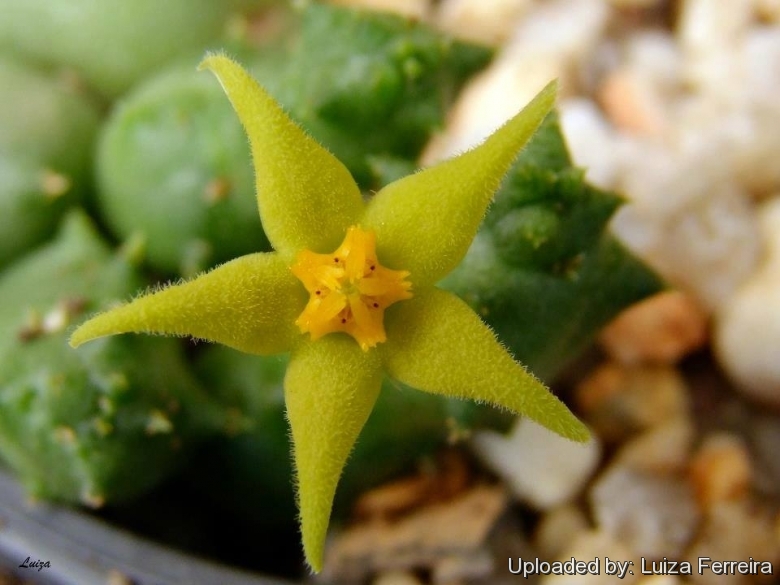Accepted Scientific Name: Piaranthus cornutus var. ruschii (Nel) Bruyns
Stapeliads S. Africa Madagascar 2: 365. 2005 Bruyns

Piaranthus ruschii (Piaranthus cornutus var. ruschii) Photo by: Luiza Ferreira
Origin and Habitat: Southern Namib, Namibia, north of the Orange River
Habitat and ecology: It grows in very arid areas.
Synonyms:
See all synonyms of Piaranthus cornutus
Description: Piaranthus cornutusSN|18024]]SN|30433]] var. ruschii is a tiny, tufted, stapeliad from Namibia characterized by globose stems with small, but bright yellow, five-pointed flowers that can be surprisingly similar to forms of Piaranthus geminatusSN|30433]]SN|18024]] of the karoo. It flowers freely, usually in clumps. It distinguishes for the non erect staminal corona-lobes.
Stems: Reclining to upright, spherical or ovoidal, up to 2 cm long, hardly edged, with short-toothed tubercles.
Flowers: Appear singly or in twos near the tip of the shoot; corolla tips are ca. 1 cm long and are greenish yellow with dense white hairs. Flowers may have a pleasant, fruity smell, but more often a rancid butter smell.
Subspecies, varieties, forms and cultivars of plants belonging to the Piaranthus cornutus group
- Piaranthus cornutus N.E.Br.: flowers brownish-yellow, pale yellowish, or whitish on the inner face heavily mottled with dark red and with with dense white hairs. Distribution: South Namibia, and north-western South Africa.
 Piaranthus cornutus var. ruschii (Nel) Bruyns: Flowers greenish yellow with dense white hairs white hairs (usually unspotted). Distribution: Southern Namib, Namibia.
Piaranthus cornutus var. ruschii (Nel) Bruyns: Flowers greenish yellow with dense white hairs white hairs (usually unspotted). Distribution: Southern Namib, Namibia.  Piaranthus pulcher N.E.Br.: Has bright clear greenish-yellow flowers, marked all over with small rounded dark purple-brown spots. Distribution: South Africa, Little Namaqualand.
Piaranthus pulcher N.E.Br.: Has bright clear greenish-yellow flowers, marked all over with small rounded dark purple-brown spots. Distribution: South Africa, Little Namaqualand.
Bibliography: Major references and further lectures
1) Werner Rauh “The Wonderful World of Succulents: Cultivation and Description of Selected Succulent Plants Other Than Cacti” Smithsonian Institution Press, 1984
Cultivation and Propagation: Piaranthus cornutusSN|30433]]SN|30433]] var. ruschii is an easy blooming plant when mature that require moderately watering through the growing season but enjoy plenty of water and some fertiliser in hot weather, this helps them to flower freely. Water more sparingly in winter according to temperatures. But, as with most asclepiads, it is unwise to leave them wet in cold weather. Winter care presents no problems at 5°C with plenty of light. Since roots are quite shallow, use a cactus mix or add extra perlite or pumice to regular soil potting soil. A gritty, very free-draining compost is suitable, and clay pots help the plants to dry out between watering.
Sun Exposure: Partial sun or light shade
Pest and diseases: Piaranthus species vary in their susceptibility to rotting, but are generally fairly easy to grow, especially if kept pest-free. They are very susceptible to stem and root mealy bugs, and damage from these may well initiate fungal attack. If you do have problems with a stem or with basal rotting, you can reliably isolate the healthy parts, dry them off, and re-root them in moist compost.
Cultural Practices: Re-pot every 2 years
Propagation: Easiest with stem cuttings. Allow cuttings to dry a day before planting. Stems must be laid (Not buried) on gritty compost and will then root from the underside of the stems. It can also be increased from seeds sowing in spring in moist, sandy peat moss.
Potting medium: Since roots are quite shallow, use a cactus mix or add extra perlite or pumice to regular soil potting soil. A gritty, very free-draining compost is suitable, and clay pots help the plants to dry out between watering.










